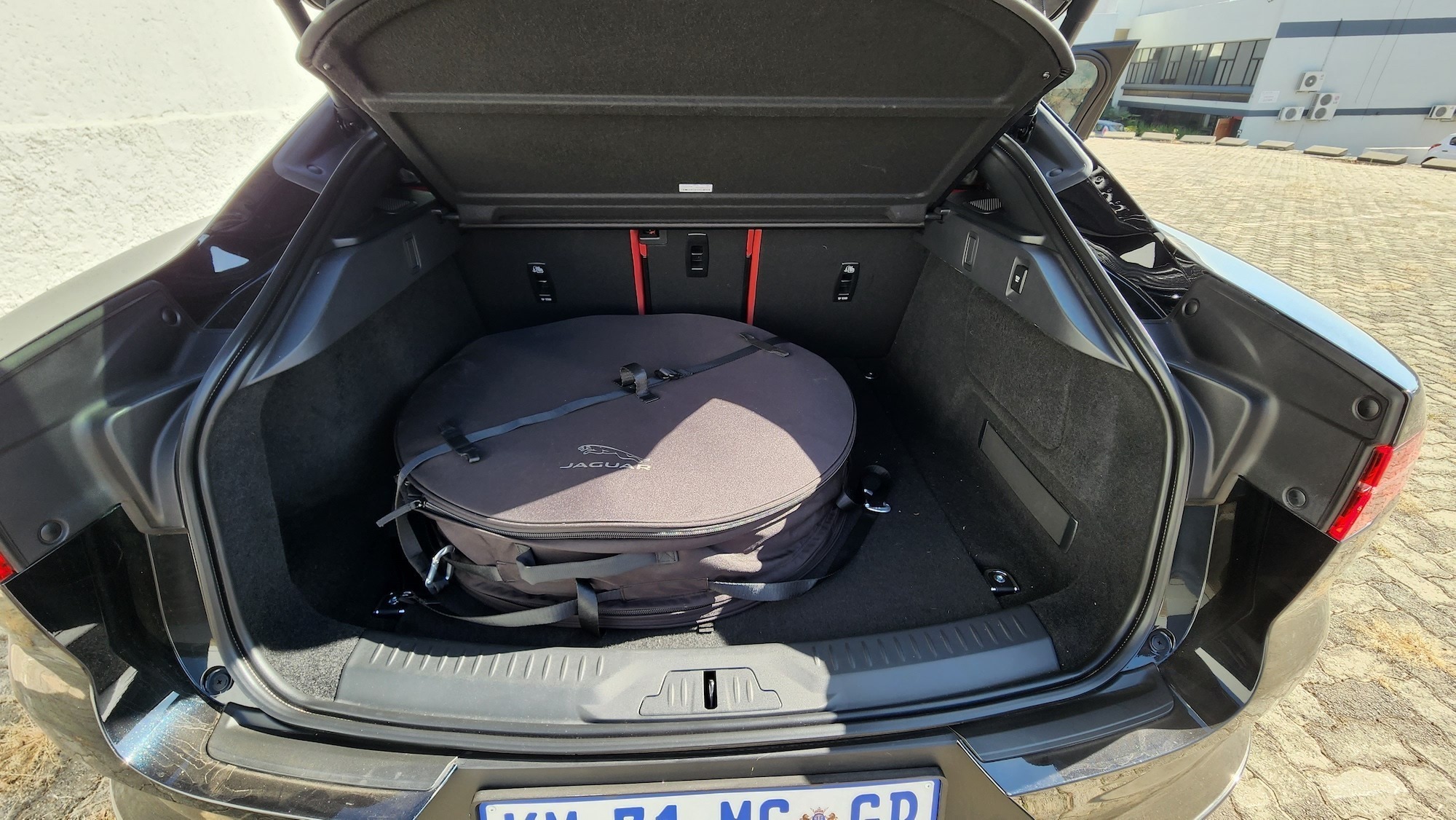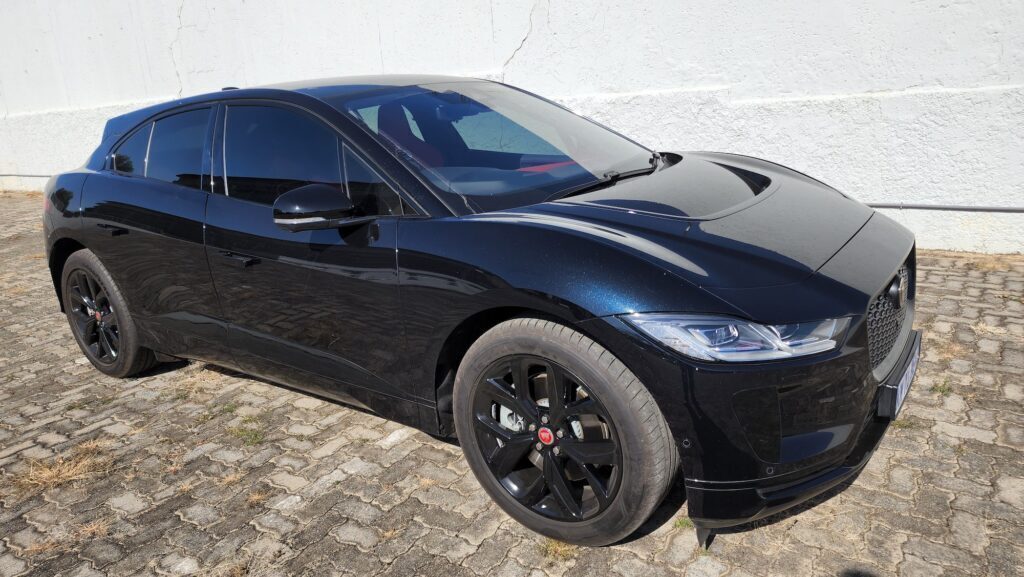If you've ever wondered what it might be like to drive a Batmobile, this is probably about as close as it gets (barring actually buying a Batmobile). There is a downside -- you almost need Bruce Wayne-level cash to afford one of these. But if you've got the scratch, it's absolutely worth taking a test drive, at the very least.
-
Design
-
Performance
-
Infotainment
-
Features
-
Price
Stuff has been on the Jaguar I-Pace’s trail since at least 2018. Our most recent encounter, with the Jaguar I-Pace Black, has done nothing to diminish the awe we have for this vehicle series. Everything about it is impressive. Its lines, its interior, its acceleration, and even its range is impressive now.
But, unfortunately, that’s not the only thing that’s awesome. It also features an awesome (in the literal sense of the word) price. Specifically, R2.25 million in the case of the 90 kW I-Pace Black that was sent to us. That’s a little over R200,000 above the base price for this model. Even then, there were a few options left off the list.
Despite the price tag, it’s still one hell of a ride. But is that ride worth the money you’re being asked to spend? That’s the question we’re here to answer.
To the Bat-Jaguar!

The front-end is pure Jaguar. The widely-spaced grille and slit-eyed headlights are aggressive, in a British kinda way. The vicious slit in the bonnet adds an extra high-speed thrill to the design. From the sides and rear, the I-Pace Black is more sports car than SUV, despite how the company categorises it. It might qualify as a sport utility vehicle in terms of weight, thanks to the batteries, but it’s a lower, more tightly-packed bundle than any SUV we’ve ever run into. Maybe it’s the black-clad 20in rims it’s sitting on. It gives the appearance of wanting to eat roads, preferably at high speed.
There’s a fair-sized boot, but it suffers from the same issues as previous I-Pace models. Namely, there’s a spare tyre living in it. There’s no hidden recess to tuck the spare away into since the rear end is loaded with lithium ions. You can either tote it around or leave it at home and hope you don’t get a puncture. Up front is the frunk (‘front truck’), which opens the same as any car bonnet. Inside, though, are your charging cables and space for precious little else.
Interior monologue
The interior is far more detailed than the Gotham Black exterior. (Okay, fine, the colour is called Farallon Pearl Black and it costs R22,300.) Mars Red leather bucket seats — no five-point harness, though, it’s not that frightening — and a black-and-red leather dashboard jump out at you like a large, jumpy thing. The window posts and ceiling (the bits that aren’t magical glass) are an Ebony-shaded suede, and there’s black and silver trim throughout.
Those looks extend to the interior door panels, which along with the door posts play host to a total of six Meridian Surround speakers. There’s also a small speaker above the driver and passenger sides, that we reckon is for the car’s SOS system. The doors themselves swing open like they’re carrying armour, and they clunk closed with a solid ‘thunk’ just before you start up this silent-but-deadly road warrior. But, again, we’re getting ahead of ourselves. First, it’s time to check out the Bat-computer.
Which, strangely, might be the most disappointing part of the I-Pace Black. The car we had for review is packing a stock infotainment system, but with Android Auto and Apple CarPlay built in. There’s nothing wrong with it, but it’s very familiar. It’s found in Land Rovers and naturally aspirated Jags, and the system is largely uncomplicated. As long as you want to do uncomplicated things. Delve into the settings and matters start getting messy. There was also the issue of Android Auto attempting to take over Jag’s standard operating system, resulting in neither of them working without a spot of nudging. And, at this price, any nudging is too much.
Setting the I-Pace
The price also demands considerable performance. That’s something that this rolling slab of metal and batteries has in excess. EVs are always an experience, but you’ll never forget the first time you nudge the accelerator and are slammed into the bucket seats by takeoff. The launch, surprisingly, is something you become used to. The feel of the car itself takes a little longer to adjust to.
It’s a little like driving a boat, only without that sensation of slippiness in the rear end. The gross vehicle weight for this Jag is 2,670kg. Throwing that around on the road seems like it would be a challenge, but the combination of Jaguar’s engineering and EV-specific instant torque makes zipping through traffic at terrifying speeds an absolute pleasure. For the driver. Other people on the road, particularly those who are counting on engine noise to notify them of incoming traffic might have different feelings.
Acceleration really is the star feature. You’ll be halfway down the block before the next car has even started pulling into the intersection. Which, yes, makes you look like a speed-happy idiot, but that’s just how EVs accelerate. If you’ve got the space, and the willingness to pay the fines, you can rocket up to the 200km/h max speed in a matter of seconds. Acceleration starts to taper off once you pass 120km/h, but we suspect that’s an artificial choice on Jag’s part. Those driving motors could probably keep you pressed against your seat for longer if traffic laws would let them. But that wouldn’t do the battery any favours, would it?
Stored potential
Jag reckons its car attains a range of between 410 and 470 kilometres on a charge. In Johannesburg, in the middle of winter, it’s definitely on the lower end of that. About 400km on a charge sounds about right, provided you’re not too much of a hooligan with the accelerator, climate control, or heated seats. The extra 50km or so actually goes a long way to alleviating our anxieties on the range front.
There was one issue, experienced when we were charging at one of Jaguar’s chargers in Lonehill. The issue was completely our fault — we’d set the car to only charge during cheaper hours while mucking with some settings. The high-speed charger simply wouldn’t connect, despite being instructed to. Flipping over to a standard charge profile fixed it, but the process for figuring out the problem was exactly the same as troubleshooting a computer. That’s a weird experience to have with a car, but we suspect it’ll soon become normal.
